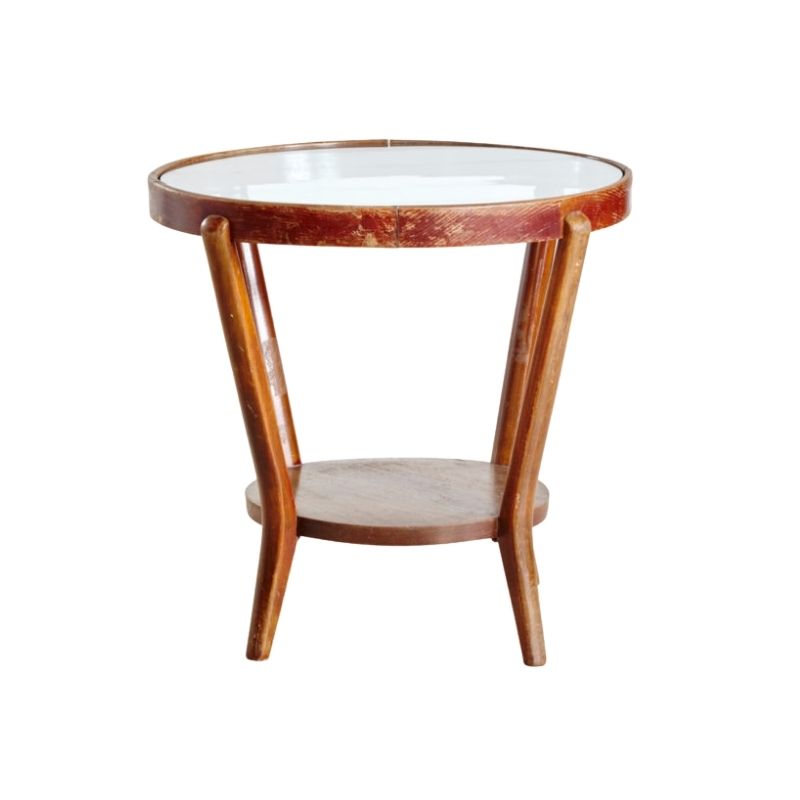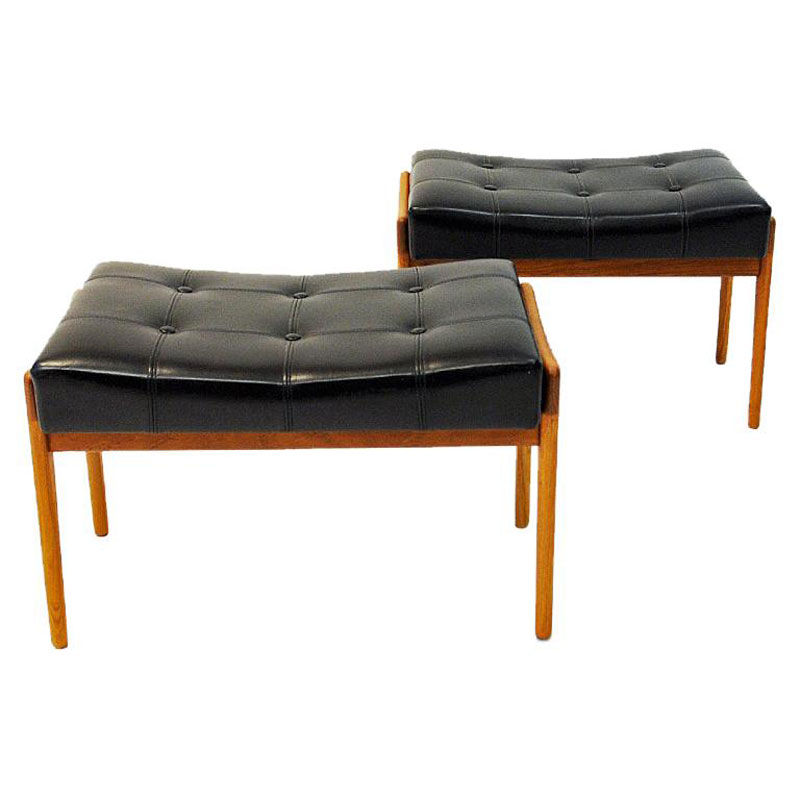I'm redoing 2 of these chairs and I'd like to know more about them but I don't see any obvious tags or markings under the chair to determine the designer. Any suggestions?
I'd like to refinish the wood - what would be the best avenue of approach? Stripper or sanding?
 <img class="wpforo-default-im
<img class="wpforo-default-im
I don't know anything about who designed or made the chairs. If you want to refinish them, the first thing you need to do is determine what the original finish is.
First, test for lacquer by dabbing a bit of acetone, lacquer thinner or nail polish remover on an inconspicuous place that has finish on it. Lacquer will start to reconstitute immediately. It will turn to a gel that you can wipe off easily.
Test for shellac the same way but with rubbing alcohol as the solvent. (It's unlikely to be shellac, but if you've ruled out lacquer you might as well rule out shellac before proceeding.)
If you got a negative for the two tests above, it's either varnish, polyurethane--which require chemical strippers for removal-- or oil.
I'm thinking it's not oil just based on details in the closeup photo you provided--looks like a clear coat finish of some kind chipping off, which means it's probably lacquer. Lacquer chips off rather than wearing off evenly, the way varnish does. The chair looks too old to have an original polyurethane on it but someone may have refinished it at some point---look for signs of this (drips, sags, dirt that was coated over, etc.)
I almost never sand when refinishing. Sanding removes the top layer of wood completely so you lose a lot of the character in the patina. It's ok when there are ugly stains that won't come out with any other method, or deep scratches, or wildly different colors due to fading, but those are pretty much the only reasons---I think---to sand.
I ended up sanding the chair - it's been slow-going but I've got most of the old brown lacquer off. I'm disappointed as you said, Spanky, that the patina is removed, but I'll do my best to bring out the fresh wood and give it the finish it deserves.
I'm thinking just teak oil - does that seem sensible or should I use something with a protective layer?
I did some tests to see what kind of finish was on the chair and I did not get the gel response for lacquer and no response to the rubbing alcohol. I was surprised that the finish didn't react to the acetone because it is indeed chipping and cracking. Since it was not clear to me at that point, I opted not to use a stripper, which I believe is still my choice since it's my project, right?
Honestly, i was just surprised, but maybe i jumped my conclusions.
No intention to complain realy and sorry if i offended you.
But someone that is very knowledgeble about the subject takes time to sit down to write you a lengthy reply giving great suggestions that it seemed from your response that you ignored.
That was what i reacted fat, if you had given a more lenghtly response i would have not opened my mouth at all..
Did the acetone do anything at all to the chippy finish? You will get the gel result only if you let a puddle of acetone sit on the finish for a minute or two. If you don't put enough on, it will evaporate before it reconstitues the finish.
It may have been polyurethane but that's unlikely in a chair of this vintage---unless it's not as old as it looks, or if someone added the finish later which is always a possibility. Either way, I am pretty sure that methylene chloride stripper would have worked on it.
Another reason I avoid sanding when at all possible is that you have to sand the entire piece very evenly. Otherwise you end up with darker areas where some of the aged darker color is left. It's a lot of work to get the color even, especially on chairs where there are rails and rungs and spindles that have to be sanded right up to the joints.
Please post photos when you're done with them.
And yes, an oil finish is fine for a chair. Tons of chairs with oil finishes look great decades later. Spend a little time reading threads here about vintage Danish furniture if you need further evidence.
Oh well maybe that's where I went wrong - I put some (a good amount) on a towel and rubbed it into the same spot. Nothing happened so I tried a few times on the same location and still, it didn't become sticky or change texture so I assumed it was a no-go. I still have the 2nd chair so I'll give it a go and see if it gels up and I'll let you know. I'll also post photos of the chair!
I completely get your point about the spots. Some of them are very stubborn but in the end it'll work out and I'll toss this experience into my mental filing cabinet!
With the water spots in the original pictures, teak graying, and most of the finish already missing on the arms, I am not sure there was much of an alternative option to sanding. Sure you could have removed most of the finish with the correct solvent or stripper, and tried to use oxalic acid to remove the water spots and graying, but then you will raise the grain and have to sand anyways. Plus sand off any stubborn finish. Unless you are talking an oil finish, or some sort of evaporative finish (shellac, Lacquer) in somewhat decent condition, you are always going to have to sand.
I agree that it can be tedious. I also agree that not all do-it-yourselfers should take it on; it is often better for this skill level to just rub it down really good with oil and 0000 steel wool a number of times as it will undoubtedly look better than a botched attempt at sanding (I know, I have messed up more than a few chairs trying to sand, when I should have just cleaned and oiled).
I think the gray tone in the wood may be due to lighting...? The fabric in that one looks a true blue whereas it has more yellow in it in the other closeup.
I can usually get water spots like the ones on the arm to disappear with oil and fine steel wool. If they don't disappear completely, they get much less noticeable.
Hi all, I wanted to post a final update on these chairs - I've finally finished them and delivered to the client.
First - I want to say that I will never take on sanding a chair like I have here if stripping or other methods are the easier option. It took SO long so lesson learned the hard way. The inside of the chair was also rotted out so I rebuilt the seats. As an new upholsterer it was also a learning experience not to believe my client when she said the chair was straightforward and wouldn't need new foam or frame repairs. I also had to repair a huge stress fracture in the corner by the seat. Despite all of those challenges I learned a heck of a lot and my client was thrilled with grandma's chairs!
One comment/question - I used Tropical Teak Oil Sealer in "Natural Light" and I was shocked at how orangy the wood became. Is this normal or should I be reading some document on different ways to treat teak? I read up extensively on this product and everyone is thrilled with it, no complaints about the color being too crazy, so maybe I'm overthinking it? On the other hand, it was difficult to explain to the client why the wood was so different from the brown that it was when she gave it to me.
She now wants me to redo the matching 3 seater. I'm still in therapy for these so, yeah 🙂


If you need any help, please contact us at – info@designaddict.com









